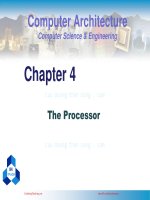kiến trúc máy tính võ tần phương chương ter05 memory sinhvienzone com
Bạn đang xem bản rút gọn của tài liệu. Xem và tải ngay bản đầy đủ của tài liệu tại đây (1.51 MB, 62 trang )
dce
2013
COMPUTER ARCHITECTURE
CSE Fall 2013
BK
TP.HCM
Faculty of Computer Science and
Engineering
Department of Computer Engineering
Vo Tan Phuong
/>CuuDuongThanCong.com
/>
dce
2013
Chapter 5
Memory
CuuDuongThanCong.com
Computer Architecture – Chapter 5
/>
©Fall 2013, CS
2
dce
Presentation Outline
2013
Random Access Memory and its Structure
Memory Hierarchy and the need for Cache Memory
The Basics of Caches
Cache Performance and Memory Stall Cycles
Improving Cache Performance
Multilevel Caches
CuuDuongThanCong.com
Computer Architecture – Chapter 5
/>
©Fall 2013, CS
3
dce
2013
Random Access Memory
Large arrays of storage cells
Volatile memory
Hold the stored data as long as it is powered on
Random Access
Access time is practically the same to any data on a RAM chip
Output Enable (OE) control signal
Specifies read operation
Write Enable (WE) control signal
Specifies write operation
RAM
n
Address
Data
m
OE
WE
2n × m RAM chip: n-bit address and m-bit data
CuuDuongThanCong.com
Computer Architecture – Chapter 5
/>
©Fall 2013, CS
4
dce
Memory Technology
2013
Static RAM (SRAM) for Cache
Requires 6 transistors per bit
Requires low power to retain bit
Dynamic RAM (DRAM) for Main Memory
One transistor + capacitor per bit
Must be re-written after being read
Must also be periodically refreshed
Each row can be refreshed simultaneously
Address lines are multiplexed
Upper half of address: Row Access Strobe (RAS)
Lower half of address: Column Access Strobe (CAS)
CuuDuongThanCong.com
Computer Architecture – Chapter 5
/>
©Fall 2013, CS
5
dce
2013
Static RAM Storage Cell
Static RAM (SRAM): fast but expensive RAM
6-Transistor cell with no static current
Typically used for caches
Word line
Provides fast access time
Vcc
Cell Implementation:
Cross-coupled inverters store bit
Two pass transistors
Row decoder selects the word line
bit
bit
Typical SRAM cell
Pass transistors enable the cell to be read and written
CuuDuongThanCong.com
Computer Architecture – Chapter 5
/>
©Fall 2013, CS
6
dce
2013
Dynamic RAM Storage Cell
Dynamic RAM (DRAM): slow, cheap, and dense memory
Typical choice for main memory
Word line
Cell Implementation:
1-Transistor cell (pass transistor)
Pass
Transistor
Trench capacitor (stores bit)
Capacitor
Bit is stored as a charge on capacitor
Must be refreshed periodically
bit
Typical DRAM cell
Because of leakage of charge from tiny capacitor
Refreshing for all memory rows
Reading each row and writing it back to restore the charge
CuuDuongThanCong.com
Computer Architecture – Chapter 5
/>
©Fall 2013, CS
7
dce
2013
Dynamic RAM Storage Cell
The need for refreshed cycle
CuuDuongThanCong.com
Computer Architecture – Chapter 5
/>
©Fall 2013, CS
8
dce
Typical DRAM Packaging
2013
24-pin dual in-line package for 16Mbit = 222 4 memory
22-bit address is divided into
Legend
11-bit row address
11-bit column address
Interleaved on same address lines
Ai
CAS
Dj
NC
OE
RAS
WE
Address bit i
Column address strobe
Data bit j
No connection
Output enable
Row address strobe
Write enable
Vss D4 D3 CAS OE A9 A8 A7 A6 A5 A4 Vss
24 23 22 21 20 19 18 17 16 15 14 13
1
2
3
4
5
6
7
8
9
10 11
12
Vcc D1 D2 WE RAS NC A10 A0 A1 A2 A3 Vcc
CuuDuongThanCong.com
Computer Architecture – Chapter 5
/>
©Fall 2013, CS
9
dce
2013
Typical Memory Structure
Select column to read/write
...
Column decoder
r
Row Decoder
Select row to read/write
Row address
Row decoder
2r × 2c × m bits
Cell Matrix
Cell Matrix
2D array of tiny memory cells
Sense/Write amplifiers
Sense/write amplifiers
Data
m
Row Latch 2c × m bits
...
Sense & amplify data on read
Column Decoder
Drive bit line with data in on write
c
Same data lines are used for data in/out
CuuDuongThanCong.com
Computer Architecture – Chapter 5
Column address
/>
©Fall 2013, CS
10
dce
DRAM Operation
2013
Row Access (RAS)
Latch and decode row address to enable addressed row
Small change in voltage detected by sense amplifiers
Latch whole row of bits
Sense amplifiers drive bit lines to recharge storage cells
Column Access (CAS) read and write operation
Latch and decode column address to select m bits
m = 4, 8, 16, or 32 bits depending on DRAM package
On read, send latched bits out to chip pins
On write, charge storage cells to required value
Can perform multiple column accesses to same row (burst mode)
CuuDuongThanCong.com
Computer Architecture – Chapter 5
/>
©Fall 2013, CS
11
dce
2013
Burst Mode Operation
Block Transfer
Row address is latched and decoded
A read operation causes all cells in a selected row to be read
Selected row is latched internally inside the SDRAM chip
Column address is latched and decoded
Selected column data is placed in the data output register
Column address is incremented automatically
Multiple data items are read depending on the block length
Fast transfer of blocks between memory and cache
Fast transfer of pages between memory and disk
CuuDuongThanCong.com
Computer Architecture – Chapter 5
/>
©Fall 2013, CS
12
dce
Trends in DRAM
2013
Year
Produced
1980
1983
1986
1989
64 Kbit
256 Kbit
1 Mbit
4 Mbit
DRAM
DRAM
DRAM
DRAM
Row
access
170 ns
150 ns
120 ns
100 ns
1992
16 Mbit
DRAM
80 ns
15 ns
120 ns
1996
64 Mbit
SDRAM
70 ns
12 ns
110 ns
1998
128 Mbit
SDRAM
70 ns
10 ns
100 ns
2000
256 Mbit
DDR1
65 ns
7 ns
90 ns
2002
512 Mbit
DDR1
60 ns
5 ns
80 ns
2004
2006
2010
2012
1 Gbit
2 Gbit
4 Gbit
8 Gbit
DDR2
DDR2
DDR3
DDR3
55 ns
50 ns
35 ns
30 ns
5 ns
3 ns
1 ns
0.5 ns
70 ns
60 ns
37 ns
31 ns
Chip size
CuuDuongThanCong.com
Type
Computer Architecture – Chapter 5
Column
access
75 ns
50 ns
25 ns
20 ns
Cycle Time
New Request
250 ns
220 ns
190 ns
165 ns
/>
©Fall 2013, CS
13
dce
2013
SDRAM and DDR SDRAM
SDRAM is Synchronous Dynamic RAM
Added clock to DRAM interface
SDRAM is synchronous with the system clock
Older DRAM technologies were asynchronous
As system bus clock improved, SDRAM delivered
higher performance than asynchronous DRAM
DDR is Double Data Rate SDRAM
Like SDRAM, DDR is synchronous with the system
clock, but the difference is that DDR reads data on
both the rising and falling edges of the clock signal
CuuDuongThanCong.com
Computer Architecture – Chapter 5
/>
©Fall 2013, CS
14
dce
2013
Transfer Rates & Peak Bandwidth
Standard
Name
Memory
Bus Clock
Millions Transfers
per second
Module
Name
Peak
Bandwidth
DDR-200
100 MHz
200 MT/s
PC-1600
1600 MB/s
DDR-333
167 MHz
333 MT/s
PC-2700
2667 MB/s
DDR-400
200 MHz
400 MT/s
PC-3200
3200 MB/s
DDR2-667
333 MHz
667 MT/s
PC-5300
5333 MB/s
DDR2-800
400 MHz
800 MT/s
PC-6400
6400 MB/s
DDR2-1066
533 MHz
1066 MT/s
PC-8500
8533 MB/s
DDR3-1066
533 MHz
1066 MT/s
PC-8500
8533 MB/s
DDR3-1333
667 MHz
1333 MT/s
PC-10600
10667 MB/s
DDR3-1600
800 MHz
1600 MT/s
PC-12800
12800 MB/s
DDR4-3200
1600 MHz
3200 MT/s
PC-25600
25600 MB/s
1 Transfer = 64 bits = 8 bytes of data
CuuDuongThanCong.com
Computer Architecture – Chapter 5
/>
©Fall 2013, CS
15
dce
DRAM Refresh Cycles
2013
Refresh cycle is about tens of milliseconds
Refreshing is done for the entire memory
Each row is read and written back to restore the charge
Some of the memory bandwidth is lost to refresh cycles
Voltage
for 1
1 Written
Refreshed
Refreshed
Refreshed
Threshold
voltage
Voltage
for 0
0 Stored
CuuDuongThanCong.com
Refresh Cycle
Computer Architecture – Chapter 5
Time
/>
©Fall 2013, CS
16
dce
2013
Expanding the Data Bus Width
Memory chips typically have a narrow data bus
We can expand the data bus width by a factor of p
Use p RAM chips and feed the same address to all chips
Use the same Output Enable and Write Enable control signals
OE
WE
OE
Address
Data
WE
OE
...
Address
Data
m
..
WE
Address
Data
m
Data width = m × p bits
CuuDuongThanCong.com
Computer Architecture – Chapter 5
/>
©Fall 2013, CS
17
dce
Next . . .
2013
Random Access Memory and its Structure
Memory Hierarchy and the need for Cache Memory
The Basics of Caches
Cache Performance and Memory Stall Cycles
Improving Cache Performance
Multilevel Caches
CuuDuongThanCong.com
Computer Architecture – Chapter 5
/>
©Fall 2013, CS
18
2013
Processor-Memory Performance Gap
CPU Performance: 55% per year,
slowing down after 2004
Performance Gap
dce
DRAM: 7% per year
1980 – No cache in microprocessor
1995 – Two-level cache on microprocessor
CuuDuongThanCong.com
Computer Architecture – Chapter 5
/>
©Fall 2013, CS
19
dce
2013
The Need for Cache Memory
Widening speed gap between CPU and main memory
Processor operation takes less than 1 ns
Main memory requires more than 50 ns to access
Each instruction involves at least one memory access
One memory access to fetch the instruction
A second memory access for load and store instructions
Memory bandwidth limits the instruction execution rate
Cache memory can help bridge the CPU-memory gap
Cache memory is small in size but fast
CuuDuongThanCong.com
Computer Architecture – Chapter 5
/>
©Fall 2013, CS
20
Typical Memory Hierarchy
Registers are at the top of the hierarchy
Typical size < 1 KB
Access time < 0.5 ns
Level 1 Cache (8 – 64 KB)
Microprocessor
Access time: 1 ns
L2 Cache (512KB – 8MB)
Registers
Access time: 3 – 10 ns
L1 Cache
Main Memory (4 – 16 GB)
L2 Cache
Access time: 50 – 100 ns
Disk Storage (> 200 GB)
Access time: 5 – 10 ms
CuuDuongThanCong.com
Computer Architecture – Chapter 5
Memory Bus
Bigger
2013
Faster
dce
Main Memory
I/O Bus
Magnetic or Flash Disk
/>
©Fall 2013, CS
21
dce
2013
Principle of Locality of Reference
Programs access small portion of their address space
At any time, only a small set of instructions & data is needed
Temporal Locality (in time)
If an item is accessed, probably it will be accessed again soon
Same loop instructions are fetched each iteration
Same procedure may be called and executed many times
Spatial Locality (in space)
Tendency to access contiguous instructions/data in memory
Sequential execution of Instructions
Traversing arrays element by element
CuuDuongThanCong.com
Computer Architecture – Chapter 5
/>
©Fall 2013, CS
22
dce
2013
What is a Cache Memory ?
Small and fast (SRAM) memory technology
Stores the subset of instructions & data currently being accessed
Used to reduce average access time to memory
Caches exploit temporal locality by …
Keeping recently accessed data closer to the processor
Caches exploit spatial locality by …
Moving blocks consisting of multiple contiguous words
Goal is to achieve
Fast speed of cache memory access
Balance the cost of the memory system
CuuDuongThanCong.com
Computer Architecture – Chapter 5
/>
©Fall 2013, CS
23
dce
Cache Memories in the Datapath
Imm
RW
Rd
0
1
BusW
32
0
1
2
3
D-Cache
0
Address
32
Data_out
1
0
1
WB Data
A
L
U
3
BusB
ALUout
A
2
Data_in
32
Rd4
RB
BusA
D
Address
Rt 5
RA
ALU result 32
32
B
PC
Instruction
Rs 5
Register File
I-Cache
Instruction
0
1
E
Rd3
Imm16
Rd2
2013
Data Block
I-Cache miss or D-Cache miss
causes pipeline to stall
D-Cache miss
Block Address
Instruction Block
I-Cache miss
Block Address
clk
Interface to L2 Cache or Main Memory
CuuDuongThanCong.com
Computer Architecture – Chapter 5
/>
©Fall 2013, CS
24
dce
2013
Almost Everything is a Cache !
In computer architecture, almost everything is a cache!
Registers: a cache on variables – software managed
First-level cache: a cache on second-level cache
Second-level cache: a cache on memory
Memory: a cache on hard disk
Stores recent programs and their data
Hard disk can be viewed as an extension to main memory
Branch target and prediction buffer
Cache on branch target and prediction information
CuuDuongThanCong.com
Computer Architecture – Chapter 5
/>
©Fall 2013, CS
25









